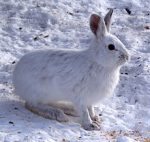Rabbit is one of the most popular pets nowadays, but instead of a domestic or captivated rabbit, have you ever wonder about a wild rabbit? Well, they are not less cute with domestic rabbits, but they definitely have some different personality traits. Talking about a wild rabbit, why don’t we discuss Arctic Jackrabbit and Jackrabbit snowshoe? Both two species are almost look alike because they have pure white fur just like snow. Now, how do we differentiate between these two? Let’s keep going!
What Are the Differences Between Arctic Jackrabbit and Jackrabbit Snowshoe?
First thing first before we get confused with the terms, there is disambiguation about the term of jackrabbits. Is it a different type of usual rabbit? The answer is yes and no. Jackrabbits are also mammals in the same family as rabbits, for short, jackrabbits are the ones that you use to call as hares. The word ‘jackrabbit’ itself comes from a book, written by Mark Twain.
So, what is arctic jackrabbit, I mean, arctic hare?
Arctic hare (Lepus arcticus) is one of the hare species that live in, you guess, Arctic tundra. Their population is spread over northernmost regions of Greenland and Northern Canada. This animal can survive in icy biomes because of its special features. They have shortened ears and limbs, small nose, and a fat thick coat of fur to keep the body warm. The body itself is not that small. They can grow up to 4.5 to 10 cm in length and 2.5 to 5.5 kg in weight! They also like to digs holes in the ground or snow to stay warm and to rest. Arctic hares are also good with running. They can run up to 60 kilometers per hour.
The best thing about Arctic hares (and mostly some of Arctic animals) is their ability to change their coat colors, from brown or grayish color in the summer to pure white color in the winter. But this is not happening to all Arctic but only to some regions besides far north Canada. Arctic hare in there remain white all year long because the summer period is very short.
And just like any other rabbits and hares, the Arctic hares are herbivores. Mostly they eat woody plants, saxifrage, crowberry, and dwarf willow. They also eat linches and mosses or twigs and roots as well.
That’s cool! How about Snowshoe hares?
The snowshoe hare (Lepus americanus), on the other hand, is a species of a hare that found in North America. They get the ‘snowshoe’ name because of their large size of its hind feet. You know, shoe. Show-shoe. Got it? These pretty feet are not only for accessories, but these parts are important for them from sinking into the snow when it hops and walks. And their thick fur, obviously, to keep them warm in freezing temperatures. The most distinguishing part that you can tell from Snowshoe hare is its ears. It has black tufts of fur on the edge of Snowshoe’s ears. It also has a grey underbelly as well.
And just like Arctic hare, Snowshoe hare can change its color as camouflage. Its fur changes into white during the winter to blend in with the snow and become rusty brown during the spring and summer.
During the summer, Snowshoe hare eats plants such as grass, leaves, or ferns. And during the winter, Snowshoe hare eats twigs, buds from flowers and plants, just like pretty rabbits (or hare) from a fairytale, isn’t it? Snowshoe hares are also known as the animal who active more at night, but they don’t hibernate like other animals who live in cold weather.
You can find Snowshoe hares in the boreal forest with a dense shrub layer. They are actually kind of shy, too.
So, what is the difference between these two hares?
1. They come from different subgenus
Of course, they are! Arctic hare comes from subgenus Poecilolagus, along with the Alaskan hare and Mountain hare. While on the other hand, Snowshoe hare come from subgenus Poecilolagus.
2. They have different behavioral adaptation
Arctic hare’s behavior is mostly feeding and grooming. They have strong claws that help them to dig in the ground or snow to make holes to rest. They like to hide in there! Arctic hare’s claws are also helpful to dig food underground like to finds plants or roots. They also have long claws on their front teeth and their feet are very dense with fur.
Snowshoe hare, on the other hand, have a different structural adaptation. Remember that they have a large pair of furry feet that help to so travel and run without sinking into the snow. They like to hide in the deep forest so it will be hard to catch them.
That’s all about the differences between Arctic hare, or jackrabbit and Jackrabbit Snowshoe. We know that Jackrabbit and Hare are actually the same but usually mistaken because of how it described in a book. Both have a white fur color that can change to a brown or grayish color, depending on the season to camouflage and hide from predators. We also know that while Arctic hare’s important features are its claws because it needs it to dig a hole for a place to sleep or just to find foods, Snowshoe hare’s important features is its feet that help it to travel a distance and keep them from sinking into the snow. And just like any other animals who need to survive in cold weather without hibernation, they have a thick fur covered up their body to the toes. There is no way they can stay warm without that dense fur that acts just like a blanket.
It’s interesting to know more about animals besides pets just like usual. An animal pet is cute. You can have them and play with them in your home. But knowing the wild animal is not less fun too, right?

